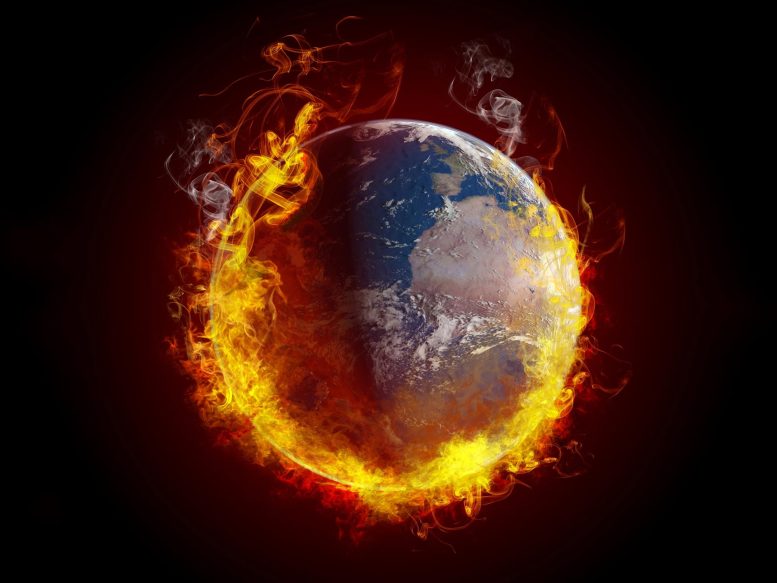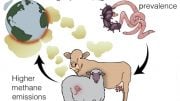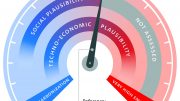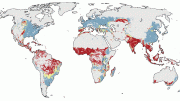
A team of over 80 experts collaborated to evaluate the impacts of climate change.
Climate change poses a significant danger to people’s health, yet solutions are within reach
Climate change is thought to have a vast range of impacts on health today. However, experts believe that this will become even more severe unless action is soon taken. The health of vulnerable groups might become more jeopardized by both direct effects, such as excessive heat, and indirect effects, such as those of decreased food and nutrition security. Outstanding scientists from around the world have teamed up to gather and assess relevant data in order to produce science-based analysis and recommendations on a global scale. They have been brought together by the world’s science academies under the umbrella of the InterAcademy Partnership (IAP). The three-year project, which included more than 80 experts from all around the globe, also looked at a variety of climate mitigation and adaptation measures that might significantly enhance health and health equity.
The researchers believe that climate change threatens the health of billions of people, even those who contribute little to climate change. However, there is good news. In the short term, various methods of reducing greenhouse gas emissions may improve health. The recent report, “Health in the climate emergency – a global perspective”, published by the InterAcademy Partnership (IAP) analyzes how climate change has an impact on global health and states the need for urgent action.
“Billions of people are at risk, therefore we call for action against climate change to benefit health and also advance health equity”, states Robin Fears, IAP project coordinator and co-author of the IAP report.
In a three-year global project, IAP has worked together with its regional networks in Africa (NASAC), Asia (AASSA), the Americas (IANAS), and Europe (EASAC) to capture diversity in evaluating evidence from their own regions to inform policy for collective and customized action at national, regional and global levels. A team of more than 80 scientists from all regions of the world has contributed to the project.
Analyzing extensive scientific evidence, the recent report offers a global review of the current knowledge and examines how climate change and its drivers are acting through a range of direct and indirect pathways to impact, for example:
- heat-related mortality and morbidity
- extreme events such as floods and droughts
- decreases in crop yield in some regions
- changes in the distribution of vector-borne diseases
- wildfires causing widespread exposure to air pollution
Generally, a wide range of health outcomes is affected including cardiovascular and respiratory diseases, water and food-borne diseases, undernutrition, and mental health. There is also a growing risk of forced migration with its attendant adverse health consequences.
An article published in Nature Climate Change, summarised in the IAP report, shows for example that one-third of heat-related deaths over recent decades can be attributed to climate change according to an analysis of data from over 700 sites in 43 countries. Moreover, other studies have found that extreme heat exposure reduces the ability to undertake physical labor, with a Lancet Planetary Health paper stating that approximately one billion people globally are projected to be unable to work safely for part of the year (even in the shade) after an increase in the global temperature of about 2.5o C above pre-industrial.
“Many policies and actions that reduce greenhouse gas emissions also benefit health in the near term as well as reducing the risks of dangerous climate change”, says Andrew Haines, Professor of Environmental Change and Public Health at the London School of Hygiene & Tropical Medicine (LSHTM) and co-chair of the IAP project. Haines is the winner of the 2022 Tyler Prize for Environmental Achievement – often regarded as the “Nobel Prize for the Environment”.
For instance, fine particulate air pollution arises from many of the same sources as emissions of greenhouse gases. Fossil fuel- and biomass-related emissions account for a substantial proportion of the total health burden from ambient pollution. According to a study published in the Proceedings of the National Academy of Sciences (PNAS), phasing out these anthropogenic sources of air pollution is projected to avert millions of premature deaths worldwide each year.
Climate change is already reducing food and nutrition security and, unless tackled, will have ever greater impacts on undernutrition and deaths. IAP underlines that promoting dietary change – increasing consumption of fruit, vegetables, and legumes and reducing red meat intake, where that is excessive – could have major health and environmental benefits. Such diets would enable significant reductions in greenhouse gas emissions from food systems as well as reduce water and land use demands. Furthermore, through the reduced risk of heart disease, stroke, and other conditions, there would be major reductions in non-communicable disease burden.
Climate action could also avert a significant increase in the spread of infectious diseases. For example, a study published in the Lancet Planetary Health estimates that the population at risk of both dengue and malaria might increase by up to 4.7 billion additional people by 2070 relative to 1970-99, particularly in lowlands and urban areas (Colon-Gonzalez et al, 2021). Thus IAP calls for strengthening communicable disease surveillance and response systems that should be a priority for improving adaptation to climate change worldwide.
The IAP report stresses that climate change affects the health of all people, but the burden is not distributed evenly or fairly.
“Instead, it falls most heavily on those in low socio-economic conditions and marginalized people and is influenced by intersecting factors such as health status, social, economic, and environmental conditions, and governance structures. Climate change impacts exacerbate inequities and injustices already experienced by vulnerable populations, many of which are founded in colonialism, racism, discrimination, oppression, and development challenges”, says Sherilee Harper, Associate Professor at the University of Alberta, Canada, and co-author of the report.
“We emphasize that health-related adaptation efforts must prioritize Indigenous Peoples, aging populations, children, women and girls, those living in challenging socio-economic settings, and geographically vulnerable populations.”
Globally, groups that are socially, politically, and geographically excluded are at the highest risk of health impacts from climate change, yet they are not adequately represented in the evidence base.
“Therefore, equity at the local, regional and international scale must be at the forefront of research and policy responses”, says Volker ter Meulen co-chair of the IAP project. “Equity is at the core of effective responses.”
IAP calls all stakeholders to take action in building climate–health resilience that will limit future risks. The very wide geographical coverage of IAP is invaluable in helping to communicate the voices of those – from low- and middle-income countries and vulnerable populations – who are not always heard during the processes whereby evidence informs international policy.
“Investing in climate-resilient infrastructure, healthcare systems, and policies will support adaptation and decrease future health risks from climate change”, adds ter Meulen. “A ‘health in all policies’ response will support climate change adaptation and mitigation actions to help meet the goals of the Paris Agreement, will have co-benefits for health, and will support the achievement of key international initiatives such as the Sustainable Development Goals.”
The study was funded by the Bundesministerium für Bildung und Forschung (Federal Ministry of Education and Research).
References: “Health in the Climate Emergency: A global perspective”, 24 May 2022, The InterAcademy Partnership.
“The burden of heat-related mortality attributable to recent human-induced climate change” by A. M. Vicedo-Cabrera, N. Scovronick, F. Sera, D. Royé, R. Schneider, A. Tobias, C. Astrom, Y. Guo, Y. Honda, D. M. Hondula, R. Abrutzky, S. Tong, M. de Sousa Zanotti Stagliorio Coelho, P. H. Nascimento Saldiva, E. Lavigne, P. Matus Correa, N. Valdes Ortega, H. Kan, S. Osorio, J. Kyselý, A. Urban, H. Orru, E. Indermitte, J. J. K. Jaakkola, N. Ryti, M. Pascal, A. Schneider, K. Katsouyanni, E. Samoli, F. Mayvaneh, A. Entezari, P. Goodman, A. Zeka, P. Michelozzi, F. de’Donato, M. Hashizume, B. Alahmad, M. Hurtado Diaz, C. De La Cruz Valencia, A. Overcenco, D. Houthuijs, C. Ameling, S. Rao, F. Di Ruscio, G. Carrasco-Escobar, X. Seposo, S. Silva, J. Madureira, I. H. Holobaca, S. Fratianni, F. Acquaotta, H. Kim, W. Lee, C. Iniguez, B. Forsberg, M. S. Ragettli, Y. L. L. Guo, B. Y. Chen, S. Li, B. Armstrong, A. Aleman, A. Zanobetti, J. Schwartz, T. N. Dang, D. V. Dung, N. Gillett, A. Haines, M. Mengel, V. Huber, and A. Gasparrini, 31 May 2021, Nature Climate Change.
DOI: 10.1038/s41558-021-01058-x
“Implications for workability and survivability in populations exposed to extreme heat under climate change: a modelling study” by Oliver Andrews, Ph.D., Prof Corinne Le Quéré, Ph.D., Prof Tord Kjellstrom, MD, Bruno Lemke, Ph.D., Prof Andy Haines, FMedSci, 1 December 2018, The Lancet Planetary Health.
DOI: 10.1016/S2542-5196(18)30240-7
“Effects of fossil fuel and total anthropogenic emission removal on public health and climate” by J. Lelieveld, K. Klingmüller, A. Pozzer, R. T. Burnett, A. Haines and V. Ramanathan, 25 March 2019, Proceedings of the National Academy of Sciences of the United States of America.
DOI: 10.1073/pnas.1819989116
“Projecting the risk of mosquito-borne diseases in a warmer and more populated world: a multi-model, multi-scenario intercomparison modelling study” by Felipe J Colón-González, Ph.D., Maquins Odhiambo Sewe, Ph.D., Adrian M Tompkins, Ph.D., Henrik Sjödin, Ph.D., Alejandro Casallas, MSc, Prof Joacim Rocklöv, Ph.D., Cyril Caminade, Ph.D., Rachel Lowe, Ph.D., 1 July 2021, The Lancet Planetary Health.
DOI: 10.1016/S2542-5196(21)00132-7









The problem with climate change, the unrecognised problem, is that the general population is not responding in a coherent manner to oft repeated and increasingly strident warnings.
And it’s not just warnings; even the most striking examples of its impact today; the destruction of the rain forests, the melting of glaciers and ice caps, the bleaching of the great coral reef in Australia, forest fires, draughts, and foods, all these are having little impact on public opinion. But why is this happening ?
One organisation has an answer, check out “Stop Selling the Desert”.
One would think — or at least hope — that “outstanding scientists” would look at the whole picture and not just one aspect. The number of excess deaths resulting from cold weather FAR exceeds those from hot weather. However, that didn’t even get mentioned in the article. Just as “A rising tide lifts all boats,” a warming world should reduce the number of deaths from cold weather. Until such time as the two extremes result in an equal number of excess deaths, I would argue that the optimal world temperature needs to be higher than it currently is.
The article expresses a concern about fine particulates in the air. However, a major source is from burning wood and fossil fuels for heat in the Winter. It is common to have a Winter-time inversion, trapping those particulates near the ground. Warmer Winters, later Falls, and earlier Springs should result in fewer heating days and thus a lower total production of fine particulates. They also neglected to mention that.
Why is it that ‘studies’ of this type invariably only look at half the equation? The standard for science used to be the “disinterested observer,” objective and free from biases. That no longer seems to be the situation. When a ‘scientist’ becomes an advocate for a particular controversial hypothesis, (s)he becomes a political lobbyist and is no longer a scientist.
Honestly nothing can be done. Oh come on now, since the mid 90’s they have been pushing to reduce CO2. But both China and India stated their economies and welfare of their people were more important. So even as the US and Europe cut CO2 their output increase so we had record CO2 levels every year except 2008 (and covid year 2020). Now China has said their increases will stop by 2035 (whoop de do). But other nations want to be economic powerhouses like China or India. So other less developed nations are roaring ahead with any cheap (fossil fuel backed) development they can. There will ALWAYS be more humans and nations willing to step into the void as others back off. And all the estimates and efforts refuse to take this into account. And if more developed nations take the effort to account for this by being more aggressive with CO2 output, well that just leaves a bigger opening for them to step in.
As long as there is no one person or government in control of the world, nothing will be done. It is that simple. Enough will be done here and there that as populations perish due to drought and famine and war, the world will peak (if not burnt to a cinder by weapons). But it WILL be a lot higher that the goals set. That is a given and can’t be stopped.
“… so we had record CO2 levels every year except 2008 (and covid year 2020).”
Interestingly, while the estimates of anthropogenic CO2 emissions suggest an average decline of 10% the the year 2020, and some months as much as 18%, there is no evidence that the amount accumulating in the atmosphere, or the monthly rate of accumulation, declined at any time in 2020. Why is that?
So… The LEAST responsible Peoples (apart from Being Born) will pay the highest price. Sounds about right, and CONSISTENT with the shape of “things” today.
PROMISE… PROMISES PROMISES… I can hear it now, in the FUTURE PERFECT WHEN: when the Truth is unavoidable and fully realized… and the SHINING, PERFECT CITIES are built upon the HIGH GROUND; the ¡WORD-UP! ⬆️ will, full of SOUND and FURY, be:”Hey, thanks for your help! UNFORTUNATELY… There’s no ROOM @ The “IN” for YOU… No ROOM for YOU in our PERFECT FUTURE WORLD.”
Same as it ever was…
In deed and INDEED, the Truth has been known since the 1970s. It had its “15 Minutes” in the Light, and was deliberately “shuffled” into OBSCURITY… STAGE RIGHT, and the SHADOWS of a RIGHT-LEANING (Staged LEFT) TOWER OF BABBLE-ON. Nothing NEW under the SUN, and “SOMETHING” continues to ROT in Denmark… or very close-by the MARK i.e.: The Mark of Cain, and the FORE(HORSE)HEADED BEASTS of the APOCALYPSE! NOW!
FORMULAIC (like the first experiment in EUGENICS): Cross a DONKEY with a HORSE and HARNESS the CART BEFORE THE BEAST. It won’t mind the stench of CORRUPTION festering right under its nose… and it cannot reproduce. BAH, HUMBUG… SOCIAL MYTH.
PAX VOBISCUM, baby.
🤞
SCOUT’S HONOR… [Whoopsies! I had my fingers crossed.]
Great Article.
Scitechdaily is helping me develope my
critical thinking skills. Thank you.